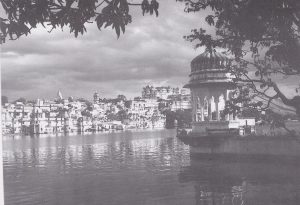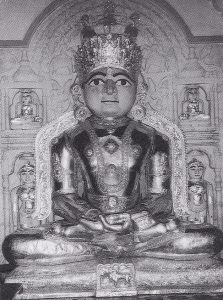Udaipur
 Udaipur, so named after Udai Singh who founded the present city in 1572- Chittorgarh had fallen to the Mughals five years earlier – has animated the romantic trait of many a foreign traveller to the present day. The above cited Hermann Keyserling, a well known German philosopher, began his journey round the globe from west to east with Ceylon and India in 1911.
Udaipur, so named after Udai Singh who founded the present city in 1572- Chittorgarh had fallen to the Mughals five years earlier – has animated the romantic trait of many a foreign traveller to the present day. The above cited Hermann Keyserling, a well known German philosopher, began his journey round the globe from west to east with Ceylon and India in 1911.
At that time Jainism was well on the way of recovering from a long period of decline, Ranakpur, however, was still in a neglected state. One wonders what Keyserling might have noted down in his Travel Diary if someone had urged him to go and see that grandiose building – as well as the four ancient Jaina temples at Ahad, three kilometres east of Udaipur’s Delhi Gate.
Still, since its foundation Udaipur has been and still is, though largely unnoticed by foreign visitors, a city with a large and active Jaina community in which all denominations are represented. There are close to forty Jaina temples in the city, about all of which are in active worship. The Shitalanatha Shvetambara Mandir, sacred to the tenth Tirthankara and located close to the Clock Tower in the heart of the city, is said to have been founded on the very day and year as the Royal Palace.
Construction of he nearby Jagdish Hindu temple began about sixty years later. The ‘glass’ temple, as the Shitalanatha Mandir is usually called, is much larger than its position in a narrow street does suggest; it has a library and two big rooms for Jaina ascetics. Westerners interested in the Jaina religion should not hesitate to inquire in this or any other temple- whether there is a monk or nun in temporary residence and if it would be all right to call on him or her.
On the opposite side of the same street, called Bada Bazar, a short distance hence, there are some more Jaina temples. Located near Bandor House in a lane deviating from the Clock Tower to the south, there is an old Digambara Adinatha temple which has an exact replica of Sammeta Shikhara carved in marble at the scale of one inch to one hundred feet: a unique piece not to be found elsewhere in India Behind the Chetak Cinema in the vicinity of Chetak Circle, a major landmark of
Udaipur, there is found, set in a quiet garden, a big Shvetambara temple named Sethi ki Badi Mandir the front wall of which is adorned with murals typical of this city. Another Jaina temple worth visiting is known by the name of Chougan ka Mandir, situated on the road from Chetak Circle to Swaroop Lake. The special attraction of this temple is the marble statue of a seated Jina (ill. 263) which is worshipped as the first Tirthankara of the next time cycle.
There are two more temples within the same compound, dedicated to Shantinatha and Mahavira respectively, as well as a secondary school, a club, a Jaina bhojan-shala (kitchen and eating-hall), and the Shri Vijaya Shanti Shiksa Bhavan.
The road from the Dehli Gate to Ahad (also Ahar), the site of four ancient Jaina temples, passes through Ashok Nagar. In Road No. 10 of this suburb there is a Digambara temple in which super-size enlargements of coloured photographs depicting Jaina holy places are on permanent display (some of them are by the present author).
As the local taxi and rickshaw drivers do not seem to be well conversant with the locations of Udaipur’s Jaina temples, it is advisable to ask for a guide at the Shvetambara dharmashala in Hathipol Road or at the Digambara dharmashala nearby.
of Udaipur’s Jaina temples, it is advisable to ask for a guide at the Shvetambara dharmashala in Hathipol Road or at the Digambara dharmashala nearby.
View of Udaipur with City Palace, seen from across Pichola Lake.
 Chougan Mandir, Udaipur. Image of the future Tirthankara named Padma Nabh Prabhu; mid eighteenth century. He will be, it is believed, the next incarnation. of the soul of Shrenika who was the ruler of Rajgir at the time of Mahavira.
Chougan Mandir, Udaipur. Image of the future Tirthankara named Padma Nabh Prabhu; mid eighteenth century. He will be, it is believed, the next incarnation. of the soul of Shrenika who was the ruler of Rajgir at the time of Mahavira.
His birth is due in the third phase of the next half-cycle of time, which will be an upward swing. No other Jaina temple is known with an image of the next Tirthankara. (To the Buddhists, king Shrenika is known under the name of Bimbisara who, later in his life, was imprisoned by his son.)
